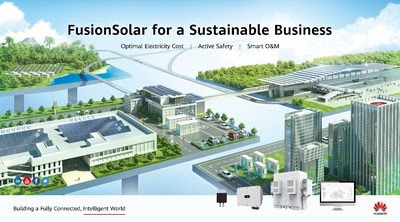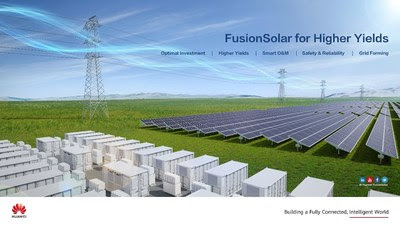MUNICH, May 11, 2022 /PRNewswire/ — Huawei today announced all-new smart photovoltaic (PV) and energy storage solutions at Intersolar Europe 2022. The intelligent solutions enable a low-carbon smart society with clean energy, demonstrating Huawei’s continuous commitment to technological innovation and sustainability.
With industry leaders, experts, and journalists around the world joining the event, Chen Guoguang, Chief Executive Officer of Smart PV & ESS Business at Huawei Digital Power, presented Huawei’s new smart solutions for utility-scale PV plants, energy storage systems, commercial and industrial applications, residential uses, and smart micro-grids.

“With over 30 years of R&D experience, Huawei continues to deliver industry breakthroughs in core technologies such as artificial intelligence, cloud computing, and power electronics,” said Chen Guoguang. “We are thrilled to launch these groundbreaking all-scenario solutions resulting from our innovation efforts, helping accelerate PV and energy storage development.”
FusionSolar Smart PV Solution 6.0+ for Higher Yields
Huawei offers optimal Levelized Cost of Electricity (LCOE), enhanced grid connection capabilities, and improved safety through continuous innovation in string design to address key industry challenges. The key technologies of its Smart PV Solution include:
- Smart DC System (SDS): Optimizing tracking algorithm, the SDS technology increases power generation by 1.69% in a PV plant in Guangxi, China. Huawei cooperates with more than 10 brands of tracking solar panels to provide users with a better experience.
- Smart I-V Curve Diagnosis 4.0: The technology identifies string faults, evaluates power loss, and recommends repair solutions, completing the full online inspection of a 100 MW power plant in 20 minutes. The diagnosis enhances operation and maintenance (O&M) while increasing power generation. In Malaysia, 2,000 hours of workload is saved every year on a 30 MW project.
- Smart String-Level Disconnector Technology (SSLD-TECH): After two years of R&D efforts, Huawei developed the innovative SSLD-TECH, which minimizes the safety hazards of direct current faults. Germany’s TÜV SÜD, IEC 60947-2 and China’s certifications ensure PV plant safety with proven effectiveness.
- Grid Forming: Developed by Huawei, the intelligent grid connection algorithm enables a PV system to be adapted to various grid scenarios, improving its voltage and power control capabilities. At a low short circuit ratio (SCR) of 1.2, it ensures that the inverter runs at full power without derating and successfully passes through high and low voltage continuously, delivering a 30% increase in new energy access.
Equipped with DC arc detection and emergency disconnection, Huawei’s Smart PV Solution cuts off faults with high precision and fast response for enhanced safety.
Smart String Energy Storage System (ESS) for Optimal Levelized Cost of Energy Storage (LCOS)
The new Smart String ESS addresses the limited capacity, short service life, complex O&M, and high safety risks of conventional solutions. Huawei draws on more than ten years of R&D experience in energy storage systems to deliver a unique smart string structure that integrates digital, power electronics, and energy storage technologies, overcoming the limitations of lithium batteries. Smart String ESS adopts pack-level optimization, rack-level optimization, distributed cooling, and all-modular design, enabling the batteries’ full charging and discharging potential and providing optimal LCOS for PV plants.

The system offers comprehensive safety with four layers of protection covering cell-level short circuit detection, pack-level safety shutdown, rack-level overcurrent protection and fault isolation, and system-level smart fire suppression.
Residential Smart PV Solution 3.0 for a Better Life
Following the launch of the “1+3+X” Residential Smart PV Solution 2.0 in 2021, Huawei presented the upgraded “1+4+X” design this year. The integrated solution enables a smart power consumption ecosystem, featuring a smart energy controller which connects a PV optimizer, an ESS, an EV charger, and a management system. This solution enhances PV self-consumption rate to 90% from 70% in the previous generation, bringing an all-around clean energy experience to homes with lower electricity costs, active safety, and intelligent assistant.

To enable low-carbon living, Huawei has launched a new smart EV charger for residential use with easy indoor and outdoor installation, delivering convenient fast charging.
Commercial & Industrial (C&I) Smart PV Solution 2.0 for a Sustainable Business

With increasing demand from enterprises to reduce electricity costs and carbon emissions, Huawei launched the upgraded 1+3 C&I Smart PV Solution 2.0 to offer customers new PV and energy storage innovations.
The new generation of the C&I Smart PV Solution comes with an all-new three-phase inverter (SUN2000-50KTL-M3), a Smart String ESS (LUNA-200kWh-2H0), which can be coupled with the 100kW power conditioning system (PCS), and a smart PV optimizer (MERC-1100W/1300W-P). It will allow companies across industries to move into a low-carbon era with optimized electricity costs, active safety, and smart O&M for an enhanced experience.

Smart Micro-grid Solution for Clean and Reliable Power Supply
Huawei launched the Smart Micro-grid Solution to support the seamless online transition of medium-voltage off/on-grid changeover. Compared to traditional power generation from oil, Huawei’s solution cuts LCOE by more than 50%. It effectively reduces power outage loss, helping to achieve zero-carbon generation and eliminate the energy divide.
Long-term Investment to Enable Continuous Innovation
Focusing on the PV sector for more than ten years, Huawei FusionSolar strives to overcome challenges across industries through continuous R&D and innovation. With its carbon-reducing solutions applied globally, the company integrates digital, AI, and cloud technologies to promote the smart development of the PV and energy storage industries.
As the president of the ENSTO-E grid code expert team and a member of IEC and UNE standard organizations, Huawei has submitted over 600 standard proposals and participated in developing more than 80 standards, making a significant contribution to the PV industry. In response to the global energy transformation toward renewable power, Huawei continues to innovate in collaboration with customers and partners to accelerate the adoption of new energy.

Committed to offering best-in-class products and services, Huawei will create more value for customers by further strengthening its leading technologies in string inverters, smart string energy storage systems, grid connection, and PV plant digitalization, helping build a sustainable, low-carbon future for the world.

